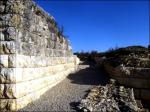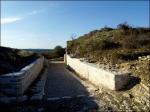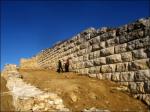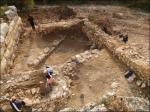Summary (English)
During 2005, systematic excavation of Asseria continued, focusing on the eastern part of the city, at the newly opened city gate. Excavations continued in the area of the western entrance to Asseria, i.e. to the late Roman propugnaculum, in the direction of the forum, and inside and outside the late Roman wall. Excavation continued also from “Trajan’s Gate” to the northeast, to the area in front of the northern part of the late Republican / early Imperial rampart, from the Republican second tower to the fifth late Roman buttress. At the western entrance to the city, in addition to the two construction horizons identified so far (late Republican/early Imperial and late Roman), the presumed pre-Roman hillfort gate has been identified. The excavation was made in front of the southern rampart at the western entrance, where the rampart takes the form of a sloping tower on which the double doors lean, and in front of the late Roman wall which closed the western entrance in the late 5th or 6th century. The edge blocks of the pre-Roman entrance to Asseria were identified, i.e. the entire width of the path that climbed along the southern rampart to the hill fort. Remains of clay as a binder were observed in some places in the structure of those irregularly carved blocks, otherwise the wall was built in the drywall technique. Remains of such Liburnian construction have already been determined in the area excavated from the first late Republican tower to “Trajan’s Gate”, i.e. in the space between the late Republican (early Imperial) rampart and the late Roman wall parallel to the rampart. The late Roman wall, right in front of the western entrance, was thickened in order to better protect the western city gates.
Research under the northern ramparts, where a vaulted late Roman tomb and skeletal burials from late 5th and 6th centuries were discovered in previous years, resulted in improved knowledge about the late Roman wall which was better built in front of the north-eastern rampart, while further north where it follows the late Republican rampart, there is almost no binding. Larger stone blocks, fragments of sepulchral and urban architecture, as well as tombstones are literally piled up to form an embankment, i.e. a barrier protecting the main defensive wall, which was probably not well maintained at that time and damaged in places. In the structure of this late Roman defensive embankment, along with fragments of pillars architectural remains, three Liburnian tombstones have been found. One is fragmentary and its inscription has not been preserved. The other two are mostly preserved and rather typical tombstones for the area of Asseria.
Late Roman tombs have been found also in the space between the earlier rampart and the late Roman embankment. Those are vaulted burials made of carved stones and spolia, as well as one child burial in an amphora and a grave lined with stone slabs and tegulae where a child had been buried with his dog.
Part of the team worked on excavating and documenting the eastern part of the city, i.e. the area within the newly discovered city gates. Besides artefacts – coins, brooches and pottery shards – a floor with some remains of mosaics was discovered. After the conservation of metal objects and ceramic finds, the layers of the investigated buildings in the eastern part of the city will be dated more precisely (I. Fadić 2006, Hrvatski arheološki godišnjak 2/2005, 297–298).
- Ivo Fadić - MUZEJ ANTIČKOG STAKLA
Director
- Ivo Fadić - MUZEJ ANTIČKOG STAKLA
Team
- Students - Sveučilište u Zadru, Odjel za arheologiju
Research Body
- Muzej antičkog stakla
Funding Body
- Ministarstvo kulture Republike Hrvatske






![Download [PDF]](/excavation/skins/fasti/images/results/download_sml.png)


